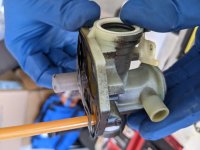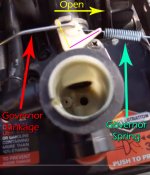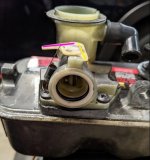You are using an out of date browser. It may not display this or other websites correctly.
You should upgrade or use an alternative browser.
You should upgrade or use an alternative browser.
Export thread
B&S 10L802-0858-F1 Run Issue (Auto-choke/Govenor?)
#1

nsnd
nsnd
First time poster, but I found your community while trying to fix a 10-year old Craftsman mower with a Briggs and Stratton 10L802-0858-F1 motor. For the past 2 years, it was used by renters, but I have since moved back to my home and started using it again. At first it didn't start, but I changed the sparkplug to an E3 Spark Plug E3.10 in September of 2020 and it's been running ever since.
Then my new problem started in February of 2021 when the mower constantly surged while mowing the lawn and puffed out black smoke from the exhaust. After some research, I came to the conclusion that I've been neglecting thing old thing and the the diaphragm was probably worn, since it had never been changed.
I ordered a replacement diaphragm and gasket directly from B&S (part# 795478) and used some carb cleaner to clean everything up. I also took this time to drain the oil and fill it back up. Once it was all put back together, same issue. I checked the E3 sparkplug and found carbon fouling (dry black fuzzy dust particles), which I understand to mean the engine has been running rich (hence the black smoke during the surging).
I did more research and found that Lowes sold the same diaphragm kit with the addition of the spring and main jet filter. Since I hadn't replaced the spring, I figured it was a good option to try. I ordered a new diaphragm kit (5083D), sparkplug (5435K), air filter (5088H), and primer bulb (5085H). Tore everything apart again and put it back together.
It took a couple tear downs after the Lowes trip to get it running, but now it's firing up and running..... somewhat. It's not surging like it was, but seems to rev up for a few moments, then die out for a few, then rev back up. Eventually the motor dies when I have the air filter on. Here's a video to help explain this:
.
When I initially took the carburetor off the engine, I had trouble disconnecting the auto-choke/governor linkage and thought I bent it. So before I order more parts and tear apart the motor any more, I thought I'd check here for more expertise on my problem.
Any help will be greatly appreciated.
Then my new problem started in February of 2021 when the mower constantly surged while mowing the lawn and puffed out black smoke from the exhaust. After some research, I came to the conclusion that I've been neglecting thing old thing and the the diaphragm was probably worn, since it had never been changed.
I ordered a replacement diaphragm and gasket directly from B&S (part# 795478) and used some carb cleaner to clean everything up. I also took this time to drain the oil and fill it back up. Once it was all put back together, same issue. I checked the E3 sparkplug and found carbon fouling (dry black fuzzy dust particles), which I understand to mean the engine has been running rich (hence the black smoke during the surging).
I did more research and found that Lowes sold the same diaphragm kit with the addition of the spring and main jet filter. Since I hadn't replaced the spring, I figured it was a good option to try. I ordered a new diaphragm kit (5083D), sparkplug (5435K), air filter (5088H), and primer bulb (5085H). Tore everything apart again and put it back together.
It took a couple tear downs after the Lowes trip to get it running, but now it's firing up and running..... somewhat. It's not surging like it was, but seems to rev up for a few moments, then die out for a few, then rev back up. Eventually the motor dies when I have the air filter on. Here's a video to help explain this:
When I initially took the carburetor off the engine, I had trouble disconnecting the auto-choke/governor linkage and thought I bent it. So before I order more parts and tear apart the motor any more, I thought I'd check here for more expertise on my problem.
Any help will be greatly appreciated.
#2
R
Rivets
R
Rivets
A couple of things I would be checking, first I hate the E plugs and would install a Champion J19LM plug. Second, check to see if you installed the carb diaphragm and gasket the correct way. The diaphragm goes against the tank and the gasket against the carb. Third, to me it sounds like it is running to fast, you need an experienced ear or tachometer to set properly. This manual may be of some help. https://drive.google.com/file/d/0B6NaqjIxWV1ycG8wd0s3Z2Q2X00/view
#3

nsnd
Thanks for the reply and the manual! I confirmed the diaphragm was installed on tank and the gasket on top (against the carb). I'll see if I can get my hands on a tach and refer to the manual you attached.
nsnd
A couple of things I would be checking, first I hate the E plugs and would install a Champion J19LM plug. Second, check to see if you installed the carb diaphragm and gasket the correct way. The diaphragm goes against the tank and the gasket against the carb. Third, to me it sounds like it is running to fast, you need an experienced ear or tachometer to set properly. This manual may be of some help. https://drive.google.com/file/d/0B6NaqjIxWV1ycG8wd0s3Z2Q2X00/view
Thanks for the reply and the manual! I confirmed the diaphragm was installed on tank and the gasket on top (against the carb). I'll see if I can get my hands on a tach and refer to the manual you attached.
#4

nsnd
nsnd
I purchased a tachometer and hooked it up. It appears the engine is running fast. When I check Table 1 (Section 5, pg. 28) for a 21" inch lawn mower blade, I should be running 3,250 RPMs. However, I'm getting a much higher number on my tachometer, generally from 5,500 to 6,000 RPMs before it starts running rough and dies.
If I'm reading the documentation correctly, I have a Pulsa-Prime carburetor (Section 3, pg.4: Fig. A; and Section 3, pg. 7), and it doesn't appear to be any adjustments on the governor. Since, linkage and spring are worn, I'm going to order new parts to ensure those are working properly.
If I'm reading the documentation correctly, I have a Pulsa-Prime carburetor (Section 3, pg.4: Fig. A; and Section 3, pg. 7), and it doesn't appear to be any adjustments on the governor. Since, linkage and spring are worn, I'm going to order new parts to ensure those are working properly.
#5

Richard320
Richard320
You might want to doublecheck that. Remember, you get a spark every revolution, whereas a lot of engines (automotive) only get a spark every other. The tach may be reading double.I purchased a tachometer and hooked it up. It appears the engine is running fast. When I check Table 1 (Section 5, pg. 28) for a 21" inch lawn mower blade, I should be running 3,250 RPMs. However, I'm getting a much higher number on my tachometer, generally from 5,500 to 6,000 RPMs before it starts running rough and dies.
If I'm reading the documentation correctly, I have a Pulsa-Prime carburetor (Section 3, pg.4: Fig. A; and Section 3, pg. 7), and it doesn't appear to be any adjustments on the governor. Since, linkage and spring are worn, I'm going to order new parts to ensure those are working properly.
#6

ILENGINE
ILENGINE
Which models of those style carb has issues with the fuel jet in the emulsion tube coming loose and falling out. Tried to find the bulletin but no luck.
#7

nsnd
nsnd
That was the callout on the tach I bought. I have the tach set for a single cylinder-four stroke engine, but that could still be an issue I need to address. I felt that when I initially took my carb off, I may have bent the governor linkage and have since tried to reset it. Not only that, but the governor spring might have also been damaged. I also noticed that when the engine is cold (I live near San Francisco, so about 50-60 degree F outside; near sea level), and I try to start it, the choke is wide open. While the engine warms, the choke closes, sputters, and re-opens. Then the process starts all over again. Correct me if I'm wrong, but the choke should start closed, then open as the engine heats. I've searched high an low, but I haven't been able to find much information on my carb/governor setup to reference.You might want to doublecheck that. Remember, you get a spark every revolution, whereas a lot of engines (automotive) only get a spark every other. The tach may be reading double.
I hope not my style. There isn't much to the carb, but I haven't seen much on it indicating that could be an issue.Which models of those style carb has issues with the fuel jet in the emulsion tube coming loose and falling out. Tried to find the bulletin but no luck.
#8

nsnd
nsnd
Received the new governor spring (B&S 698719) and linkage (B&S 698835) and installed them. I definitely mutated the linkage and the spring was also worn (see image below). Now I'm have trouble getting the mower to even start. I poured few drops of gas in the carb, and it will fire right up, but immediately dies.
One things that's been bugging me is the primer bulb I installed. Come to find out, it was a dry primer bulb (694395; 219706 from Lowe's) instead of the wet primer bulb (694394) that I removed originally. So before I go any further, I'm ordering the correct primer bulb, and I'll replace that bad boy again.
Learning experience :-D.

One things that's been bugging me is the primer bulb I installed. Come to find out, it was a dry primer bulb (694395; 219706 from Lowe's) instead of the wet primer bulb (694394) that I removed originally. So before I go any further, I'm ordering the correct primer bulb, and I'll replace that bad boy again.
Learning experience :-D.

#9
B
Bellcrank
B
Bellcrank
On this model the air filter clogs often causing the spark plug to foul. If you do not do a complete carb cleaning (Take'n every removable part off the carb and cleaning ) just buy a new carb. This video shows how NOT to clean your carb :
. This video shows how to clean your carb correctly :
.
#10

nsnd
nsnd
Bellcrank, Thank you for those videos. I believe I saw the first one (don't), but never watched the second one (do), at least not in it's entirety. Other videos referenced cleaning the main jet, but I never saw how they removed it. After watching that video, I was able to check that, while I tore apart the carb to clean and install the new primer bulb.
Lawn mower is running again, but rough with black smoke. I ordered a new Champion J19LM spark plug. Hopefully, that will be my last purchase :-D.
Lawn mower is running again, but rough with black smoke. I ordered a new Champion J19LM spark plug. Hopefully, that will be my last purchase :-D.
#11
R
Rivets
R
Rivets
If it is running with black smoke it is set too rich. If you tried to clean the main jet you may have made it too large, causing a rich condition.
#12
B
Born2Mow
B
Born2Mow
Black smoke is always a "rich" fuel mixture condition. Which shows on the plug as black soot.
Several issues can cause that. Some as simple as a dirty air filter.
(Sorry, typing the same time as Rivets)
Several issues can cause that. Some as simple as a dirty air filter.
(Sorry, typing the same time as Rivets)
#13

nsnd
nsnd
So here's an updated video on how it's running, real rough, and looks like black smoke from the exhaust. I pulled the sparkplug after about 5 minutes of resting, and it looks a little wet and smells like gas. Not sure if there's oil on the plug or not.
When I cleaned the main jet, I did not use a drill bit, only carb cleaner. It was pretty clean as it was.
When I cleaned the main jet, I did not use a drill bit, only carb cleaner. It was pretty clean as it was.
#14

nsnd
nsnd
I forgot to address the air filter in my reply. It's a brand new air filter. When I pull off the air filter completely, the engine revs up a little but continues in the same fashion with the black smoke. I only ran it this way for about 60 seconds.Black smoke is always a "rich" fuel mixture condition. Which shows on the plug as black soot.
Several issues can cause that. Some as simple as a dirty air filter.
(Sorry, typing the same time as Rivets)
#16
R
Rivets
R
Rivets
To be honest with you, i can’t remember if I’ve ever replaced the entire carb on one of those engines. If you only used carb cleaner I don’t see how you could have enlarged the jet. Two things I would do before you go that route. First, remove the carb from the tank and double check to make sure you have install the carb diaphragm and gasket correctly, plus did you also install the return spring. I know you have checked this before, but humor me. Second, read this service bulletin about how to install and tighten the carb to the tank, before installing it back on the tank. These steps do make a difference. Test run the unit to see if there is a difference. Also, reread the manual section on pulsa prime carbs, but DO NOT remove the primer or pickup tube. Let us know what happens.
#17

Richard320
Richard320
If you had the carb off and started disassembly, could you have messed up the float somehow?
#19
S
SmallEngineHead160
S
SmallEngineHead160
I would get new carb.
Check out the knockoff ones on ebay. I have used a few of them and they seem to work fine and are cheaper then oem.
Check out the knockoff ones on ebay. I have used a few of them and they seem to work fine and are cheaper then oem.
#20

nsnd
I paid particular attention to the position of the throttle during the tightening of the screws from the carb to the tank; this wasn't something I did before.
Unfortunately, it still runs pretty rough. I did notice that the RPM's were much lower today than they were yesterday (3,250 vs 2,850). Other than removing the second paper gasket, I installed a different fuel pump spring**. This may have caused the lower RPM's, but I'm not sure.

**The different fuel pump spring was used because I accidently dropped a spring and it got stuck with the other one. I couldn't tell them apart, so I may have installed an older spring.
nsnd
I wasn't able to find the service bulletin to install and tighten the carb to the tank, but was able to complete the other items you recommended. Previously, I had used "Slipper's Trick" from the how-to video, but for this purpose, I removed the second paper gasket that would have touched the tank.To be honest with you, i can’t remember if I’ve ever replaced the entire carb on one of those engines. If you only used carb cleaner I don’t see how you could have enlarged the jet. Two things I would do before you go that route. First, remove the carb from the tank and double check to make sure you have install the carb diaphragm and gasket correctly, plus did you also install the return spring. I know you have checked this before, but humor me. Second, read this service bulletin about how to install and tighten the carb to the tank, before installing it back on the tank. These steps do make a difference. Test run the unit to see if there is a difference. Also, reread the manual section on pulsa prime carbs, but DO NOT remove the primer or pickup tube. Let us know what happens.
I paid particular attention to the position of the throttle during the tightening of the screws from the carb to the tank; this wasn't something I did before.
Unfortunately, it still runs pretty rough. I did notice that the RPM's were much lower today than they were yesterday (3,250 vs 2,850). Other than removing the second paper gasket, I installed a different fuel pump spring**. This may have caused the lower RPM's, but I'm not sure.

**The different fuel pump spring was used because I accidently dropped a spring and it got stuck with the other one. I couldn't tell them apart, so I may have installed an older spring.
#21
R
Rivets
R
Rivets
I’ll try again with the bulletin. https://bsintek.basco.com/BriggsDocumentDisplay/P5.6uIX-nfBhU7y.pdf
#22

nsnd
nsnd
Ah perfect. I did follow that procedure; luckily, it was also in the manual you shared with me.
#23

nsnd
nsnd
Ripped it apart again and put the other spring in; RPM's back to normal-ish. Also, swapped another new diaphragm with the same results. I took slowmo video and focused on the exhaust and blade (just in case).
#24
B
Born2Mow
B
Born2Mow
The easiest way to make an engine run rich is for the choke to be partially ON. As I remember these carbs have sort of an automatic choke setup, so you really can't tell what position it's in. I'm wondering if you can bend an 8" piece of mechanic's wire to force the choke butterfly into a constant full open (or fully OFF) position. 8" is long enough where there's no danger of it being sucked into the engine.
If it runs no better we can rule out the choke.
Apologies if this has already been ruled out.
If it runs no better we can rule out the choke.
Apologies if this has already been ruled out.
#25

Scrubcadet10
Scrubcadet10
No choke. Primer carb.The easiest way to make an engine run rich is for the choke to be partially ON. As I remember these carbs have sort of an automatic choke setup, so you really can't tell what position it's in. I'm wondering if you can bend an 8" piece of mechanic's wire to force the choke butterfly into a constant full open (or fully OFF) position. 8" is long enough where there's no danger of it being sucked into the engine.
If it runs no better we can rule out the choke.
Apologies if this has already been ruled out.
#26

nsnd
nsnd
I notice the throttle is almost always completely open, even during a cold startup. When force the throttle closed, the RPM's increase (which seems counterintuitive to me...) and it starts to run smoother, but still seems to have the rich running appearance.
Top View - Operator Side

Side View - Engine Side

Top View - Operator Side

Side View - Engine Side

#27

nsnd
nsnd
Lawn needed to be mowed today, so I decided to take the mower for a spin. I realized it wasn't running normal RPM's (so my tach is definitely off; @Richard320 :-D). I noticed there was very little air movement from the blade, which is in good shape. I fixed the throttle open by removing the governor spring and used a piece of copper wire to hold it in a fixed position. It ran better and stopped spitting smoke.
However, even with the throttle in a fixed position, I couldn't get the RPM's to step up without the mower trying to die. Going to take a break and inspect everything I can see.
However, even with the throttle in a fixed position, I couldn't get the RPM's to step up without the mower trying to die. Going to take a break and inspect everything I can see.
#28
R
Rivets
R
Rivets
The governor spring attaches to a metal plate sticking up, right? This plate needs to be bent outward, lengthening the spring to set the governed top speed. Take a needle nose pliers and slowly bend it away from the carb until yo get the speed you need. Bending it in will slow the engine speed.
#29

nsnd
Since I previously messed up the governor, I followed the instructions in this video to reset it:
. The mechanical governor had absolutely no pressure applied. Same results though: throttle stays completely open while running. (Side note: I accidently set the governor with the throttle closed. I re-adjusted to have the throttle open instead.)
What's the best way to check that mechanical governor, take apart the engine?
nsnd
I gave it a shot, but the throttle stays completely open (see my picture labeled: Top View - Operator Side). I have to forcefully work against the spring (close the throttle) to get it running better (stop running rich and increase RPM's).The governor spring attaches to a metal plate sticking up, right? This plate needs to be bent outward, lengthening the spring to set the governed top speed. Take a needle nose pliers and slowly bend it away from the carb until yo get the speed you need. Bending it in will slow the engine speed.
Since I previously messed up the governor, I followed the instructions in this video to reset it:
What's the best way to check that mechanical governor, take apart the engine?
